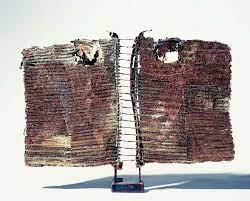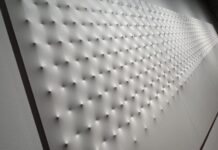Secolo breve
“Per quanto noi possiamo sapere, il ruolo e perfino la sopravvivenza nel ventesimo secolo delle arti, oggi ancora vive, restano oscuri”, scrive Eric J. Hobsbawm nel suo libro Il secolo breve – 1914-1991: l’era dei grandi cataclismi. Conclusione inquietante, la sua, che richiede una riflessione non supina.
Oltre Parmenide Il destino sta al di là dalla complessità della storia dell’Occidente con il suo tramonto dell’episteme, con l’avvento dell’apparato della scienza e della tecnica che è la realizzazione della Repubblica di Platone, cioè del progetto filosofico essenziale dell’Occidente che porta con sé la Follia di cui Parmenide è il primo angelo (come lo definisce Emanuele Severino). Egli mostra per primo che il mondo è un’illusione, che l’essere è ciò che sta al di là degli essenti come la luce sta al di là dei colori. Così uno spiraglio rimane nell’angosciante paradiso della tecnica: l’isolamento del destino che non è il futuro ma forse è semplicemente l’Arte con il suo inaudito senso dell’assurdo. Oggi più che mai.
Vicino ai greci La nostra sensibilità è più vicina a quella dei greci. C’è uno strano rapporto tra il Duemila e l’epoca classica. E questa sintonia con i greci non è casuale. La nostra scienza ribadisce il carattere indecifrabile dell’infinito. Per i greci l’infinità o apeiron era l’indeterminato, il vuoto, ciò che non si conclude. Oggi per noi lo è l’infinito. La grande mostra Cosmos. L’arte alla scoperta dell’infinito apre la stagione 2000 a Venezia. Per il nostro poeta filosofo di Recanati proprio dal senso dell’infinito nasce la lirica, quindi l’arte. Ma questo avviene in un perpetuo sbilanciamento in cui l’artista che cerca di descrivere l’infinito si trova corpo a corpo con la percezione dolorosa della sua contingenza e finitezza.
Già. Siamo all’inizio di una nuova era, caratterizzata da una grande insicurezza, da una crisi permanente e dall’assenza di ogni tipo di status quo. Il secolo è terminato, lasciando aperti i problemi per i quali nessuno ha o nessuno dice di avere soluzioni. Mentre gli uomini di questa fine-o-inizio secolo-o-millennio cercano nella nebbia globale la strada per avanzare. Tutto ciò che sanno con certezza è che un’epoca della storia è finita. Ma è vero poi?
Siamo arrivati al nuovo secolo attraverso una serie di mutazioni naturali. La libertà e la vita non hanno modelli preordinati, tuttavia le vere reali mutazioni sono quelle che risultano continue, connaturate. “É ingenuo credere di potersi spogliare di tutte le certezze e di edificare un sapere in vitro”, scrive Wittgenstein.
Superamento della dialettica e elogio alla differenza
Il mondo dissimulava secoli di ragione. Ma ecco che i primi decenni del Novecento vedono distrutto il patrimonio formale basato sugli ordini classici. L’intero apparato accademico viene azzerato in nome del principio di asimmetria e dissonanza, comune a tutta l’arte moderna, seguite dalla tridimensionalità anti-prospettica che nasce dal cubismo. Futurismo e metafisica aprono come una tenaglia l’arte del XX secolo. Sembrano provenire da due differenti punti della storia, da un’inquietudine che ha le sue radici nel romanticismo: il futurismo dal lato dionisiaco-frenetico – inizia la sarabanda dei frammenti, la metafisica dal lato apollineo-trascendentale.
L’opera d’arte non parte più da una sintesi a priori, né ambisce a raggiungere una sintesi a posteriori, sconvolto anche il rapporto tra il centro e la periferia. A questo punto interviene il concetto della percezione. Nella coralità discorde degli scorci nascono i testi del subconscio. Che sono in realtà i testi della coscienza. Già nel suo romanzo-cattedrale Proust, vero eroe della filosofia del Novecento, ci invita al distacco dall’obiettività, ci prospetta la filosofia della crudeltà, il nuovo concetto dello spazio, del vuoto, della psicologia dello spazio, dell’attraversamento, della differenza, l’attenzione passionale al frammento. Ci insegna un nuovo approccio all’arte, ci aiuta a salire verso l’astrazione. Cosicché siamo pronti ai principi della scomposizione prima e della decostruzione poi. Pensiero, messo a fuoco da Jacques Derrida.
Il superamento della dialettica degli opposti, l’attraversamento, analizzato da Proust, il suo elogio alla differenza, decostruzionismo teorizzato da Derrida, insomma – complessità. Quindi caos in versione moderna, nuovo classica.
Caos della nuova classicità
Dal costruttivismo al decostruzionismo. La differenza non è ma avviene. Sembra che velikij peredel, la grande redistribuzuione, cioè il grande caos negli anni Venti in Russia, che consolida il costruttivismo, ora de-costruendo la figura nello spazio d’arte, crei la nostra fin-de-ciècle: nuova classicità del peredel.
La fine dell’Ottocento nella stessa Russia crea lo stile neorusso, nuovo russo: versione non meno esuberante di quella spagnola dell’Art Nouveau, ma con le punte diamantine del rigore futuribile. Le avanguardie storiche segnano l’epoca. Ora ne siamo i figli, nella nuova classicità, appunto, quella del caos che non ha niente a che fare con il disordine.
Dopo il nucleo centrale del Novecento un’immensa mappa geometrizzante di eserciti milionari col passo d’oca di tutti i colori e altrettanti numeri di croci sui campi sterminati. Correvano i tempi della relatività, quantistica e matematica frattale. Il caos è vera scoperta. L’ordine fu atroce. Il disordine divenne liberatorio. Di certo scoperta estetica non era: si sa quant’è elegante un esercito perfetto che marcia in parata, un meccano gigante. Ne segue il cosmico autodafè dell’etica che cerca di salvare l’anima del mondo. Nel nuovo caos, appunto. Una lacerazione, però, si presenta, un’altra volta, tra l’etica e l’estetica. Com’è possibile?
Dapprima una violenta flessione sismica. Da Gandhi alla casa del fascio. Dal delirio fantastico al delirio della geometrizzazione militare. Più imperfetti (caotici?) erano i russi. I club-degli-operai erano nel loro cubo-costruttivismo altrettanto delirio-fantastici ma, grazie a Dio, imperfetti, come le ottomila colonne di Pietroburgo – nessuna uguale (parola di Ezio Frigerio) – che avrebbe fatto venire l’attacco di bile a un mastro architetto italiano delle epoche alte. Statico e instabile, l’ammasso geniale delle forme dei pochi edifici realizzati negli anni Venti in Russia era già caotico. E allora, costruzione? Suprematismo? De-costruzione? Dai club-degli-operai al Guggenheim Museum di Bilbao.
Certo l’itinerario della cultura moderna è continuamente ostacolato da riflussi, opposizioni, desideri di abdicare. Nel riflusso del Postmoderno si è perso l’originale ma anche la copia. L’arte sovietica degli anni Trenta era già postmoderna, la musica di Stravinskij era già citazionista. Questo abbiamo costatato negli infelici anni Ottanta. Ma già nel 1988 il decostruttivismo, lanciato con intensità in architettura, sbarazza il campo da ogni scoria, inaugurando il nuovo secolo, il millennio nuovo. Quello che è stato l’Art Nouveau nell’ultimo decennio dell’Ottocento, lo è nell’ultimo del Novecento il decostruttivismo organico. Le facciate fluttuanti del liberty non ricordano forse i nuovi decostruzionismi nipponici? Di certo non si tratta di solo architettura. Ecco comunque la storia di ogni arte che è mera, infinita citazione quando non crolla per fare uno sfasamento: famoso scalino di Malevič.
Tomorrows
Short century
Eric J. Hobsbawm writes in his book The short century – 1914-1991: the era of the great cataclysms “As far as we know, the role and even the survival in the twentieth century of the arts, still alive today, remain obscure”. He draws a disturbing conclusion, which requires non-supine reflection.
Beyond Parmenides
Destiny lies beyond the complexity of Western history with its decline of the episteme, with the advent of science and technology. This is the realization of Plato’s Republic, that is, the essential philosophical project of the West that brings with it the Madness, of which Parmenides is the first angel (as Emanuele Severino defines him). He is the first to show that the world is an illusion, that being is what lies beyond living beings as light is beyond colors. Thus, a glimmer remains in the distressing paradise of technology: the isolation of destiny which is not the future but perhaps is simply Art with its unprecedented sense of the absurd. Today more than ever.
Close to the Greeks
Our sensitivity is closer to that of the Greeks. There is a strange relationship between the 2000s and the classical era. Of course, this harmony with the Greeks is not accidental. Our science reaffirms the indecipherable nature of the infinite. For the Greeks, infinity or apeiron was the indeterminate, the emptiness, which has no end. Today we call it infinity. The great exhibition Cosmos. Art to discover the infinite opens the 2000 season in Venice. For our poet and philosopher from Recanati it is precisely from the sense of infinity that lyric is born, and therefore art. However, this happens in a perpetual imbalance in which the artist who tries to describe the infinite finds himself hand-to-hand with the painful perception of its contingency and finiteness.
We are at the beginning of a new era, characterized by great insecurity, a permanent crisis, and the absence of any kind of status quo. The century is over, leaving open the problems for which no one has, or no one claims to have solutions. In the meanwhile, the men of this end-or-beginning of the century-or-millennium seek the way forward in the global fog. All they know for sure is that an historical era is over. But is it true then?
We have arrived in the new century through a series of natural mutations. Freedom and life do not have preordained models. However, the real mutations are those that are continuous, innate. Wittgenstein writes “It is naive to believe that we can strip ourselves of all certainties and build knowledge in vitro”.
Overcoming dialectics and praising difference
The world concealed centuries of reason, but the first decades of the twentieth century saw the destruction of the formal heritage based on the classical orders. The entire academic apparatus has been cleared in the name of the principle of asymmetry and dissonance, common to all modern art, followed by the anti-perspective three-dimensionality that arises from Cubism. Futurism and metaphysics open the art of the twentieth century like a pincer. They seem to come from two different points in history, from a restlessness that has its roots in romanticism: futurism from the Dionysian-frenetic side – the saraband of fragments begins, metaphysics from the Apollonian-transcendental side.
The work of art no longer starts from an a priori synthesis, nor does it aspire to reach an a posteriori synthesis. Moreover, also the relationship between the center and the periphery is disrupted. At this point the concept of perception intervenes. In the discordant chorus of the views, the texts of the subconscious are born, which are actually the texts of conscience. In his cathedral-novel Proust, a true hero of twentieth-century philosophy, already invites us to detach from objectivity. He presents us with the philosophy of cruelty, the new concept of space, of emptiness, of the psychology of space, of crossing, of difference, of the passionate attention to the fragment. It teaches us a new approach to art, helping us to move towards abstraction. So, we are ready for the principles of decomposition first and then deconstruction, which Jacques Derrida brings into focus.
The overcoming and the crossing of the dialectic of opposites, analyzed by Proust, his praise to difference; the deconstructionism theorized by Derrida. In a word: complexity. So, it is chaos in a modern, new classic version.
Chaos of the new classicism
From constructivism to deconstructionism. The difference is not, but it happens. It seems that velikij peredel, the great redistribution (the great chaos in the 1920s in Russia, which consolidates constructivism, now de-constructing the figure in the art space) creates our fin-de-ciècle: new classicism of the peredel.
The end of the nineteenth century in Russia itself creates the neo-Russian style, the new Russian, which was no less exuberant than the Spanish version of Art Nouveau. However, it had the diamond points of futuristic rigor. The historical avant-gardes mark the era. Now we are its children. In fact, in the new classicism, there is chaos which has nothing to do with disorder.
After the central core of the twentieth century, there was an immense geometrical map of millionaire armies with goose steps of all colors and as many numbers of crosses on the endless fields. There were times of relativity, quantum, and fractal mathematics. Chaos is real discovery. The order was atrocious. The disorder became liberating. It certainly was not an aesthetic discovery: you know how elegant a perfect army marching on parade, a giant Meccano, is. This is followed by the cosmic auto-de-fe of ethics that seeks to save the soul of the world in the new chaos. However, a laceration appears once again between ethics and aesthetics. How is it possible?
First, a violent seismic decline. From Gandhi to the Casa del Fascio. From the fantastic delirium to the delirium of military geometrization. The Russians were more imperfect (chaotic?). The workers’ clubs, in their cube-constructivism just as delirious-fantastic but, thank God, imperfect, were like the eight thousand columns of Petersburg – none was equal (word of Ezio Frigerio) – which would have caused a bilious attack to an Italian master architect of the high ages. Static and unstable. The ingenious mass of shapes of the few buildings built in the 1920s in Russia was already chaotic. So, what about construction? Suprematism? De-construction? From the workers’ clubs to the Guggenheim Museum in Bilbao.
Of course, the itinerary of modern culture is continually hindered by ebbs, oppositions, the desire to abdicate. In the ebb of the Postmodern, the original thing was lost but also its copy. Soviet art of the 1930s was already postmodern and Stravinsky’s music was already quotationist, as we realized in the unhappy eighties. However, already in 1988 deconstructivism, launched with intensity in architecture, clears the field of all dross, inaugurating the new century, the new millennium. What Art Nouveau was in the last decade of the nineteenth century, organic deconstructivism is in the last decade of the twentieth century. Do the floating facades of Art Nouveau recall the new Japanese deconstructionisms? It is certainly not just architecture. However, here is the story of every art that is mere, infinite quotation when it does not collapse to make a difference: the famous step of Malevich.








